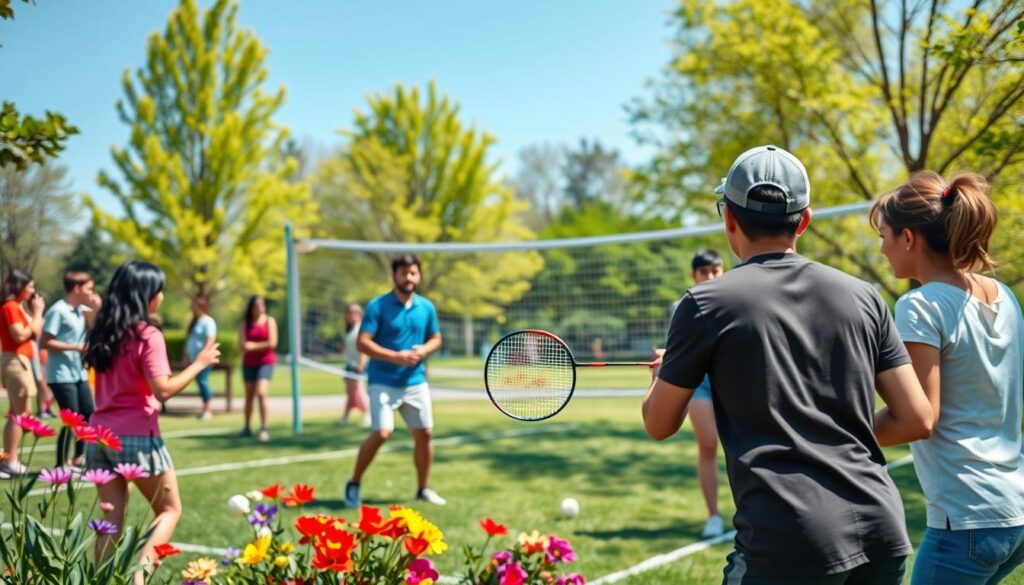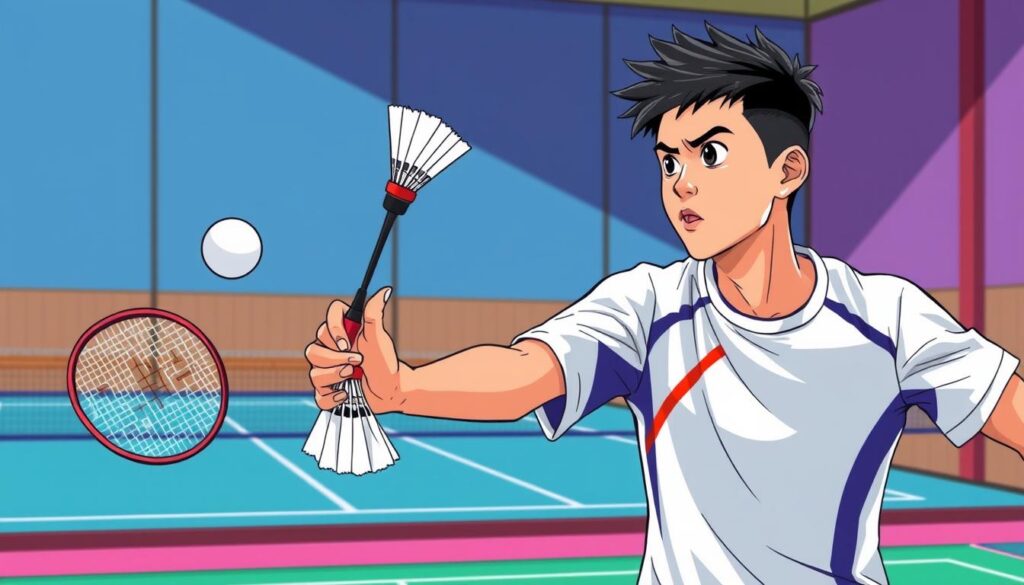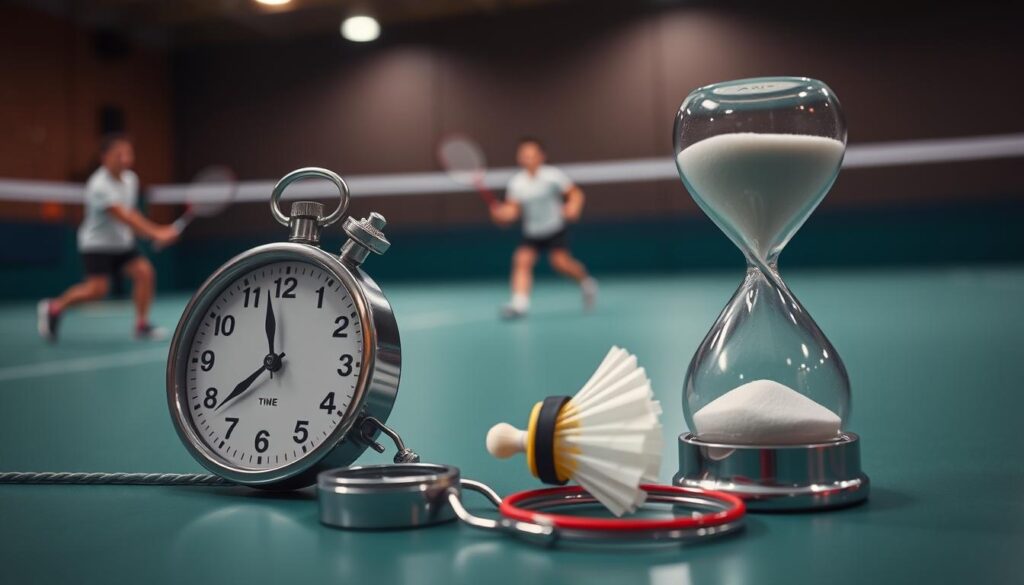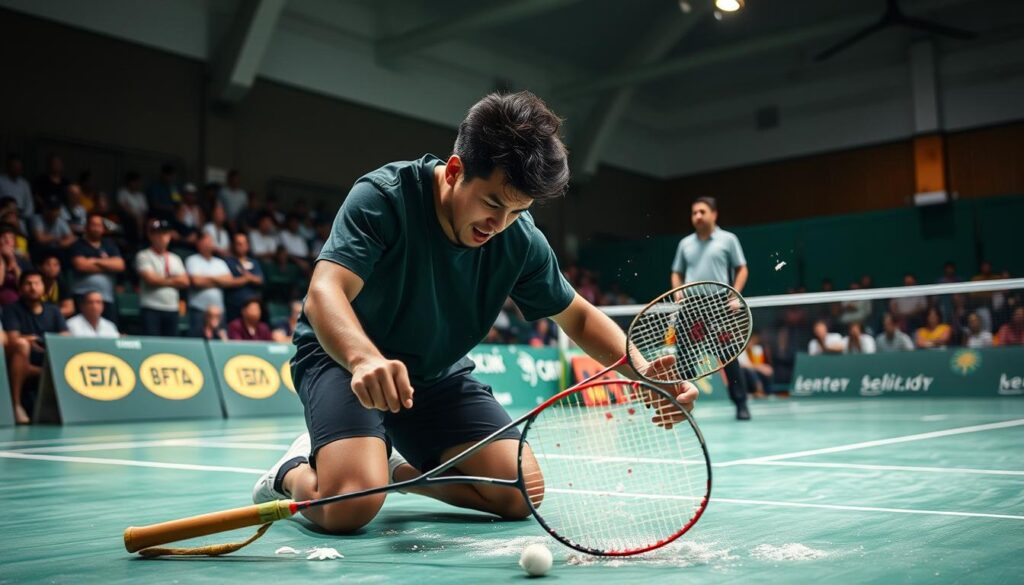Badminton is a popular Olympic sport with a rich history. Knowing its rules and regulations is key for players, officials, and fans. The Olympic badminton tournament has 5 events, including Women’s singles and Men’s singles. It also has Women’s doubles, Men’s doubles, and Mixed doubles, all in a best-of-three format.
For those new to badminton, a detailed guide is essential. It should cover badminton rules, regulations, and the basics of the game.
Badminton has a history dating back about 2000 years. It’s now played worldwide, either by two players or four. A match is divided into three games, each to 21 points. The rally scoring system gives a point to the winner of a rally.
This introduction to badminton rules and regulations is a starting point. It will help you understand the game’s details, including rules, regulations, and how to succeed.

Key Takeaways
- Badminton is a popular Olympic sport with a rich history and global reach.
- Understanding badminton rules and regulations is essential for players, officials, and fans.
- A detailed badminton guide covers rules, regulations, and the game’s basics.
- Badminton matches follow a best-of-three format, with each game to 21 points.
- The rally scoring system awards one point to a player or team who wins a rally.
- A standard badminton match has three games, with the winner being the first to win two games.
Introduction to Badminton
Badminton is a popular racquet sport with a rich badminton history spanning over two centuries. It started in British India and the first official rules were made in Poona (Pune) in 1873.
The objective of badminton is simple. Players hit the shuttlecock over the net into the opponent’s court. They aim to make it impossible for the opponent to return.

Brief History of the Sport
The first All England Open Badminton Championships were in 1899. This was the beginning of formal competitive badminton. The Badminton Association of England (BAE) was formed in 1893 to standardize the game.
Basic Objective of the Game
The game is played in a best-of-three games format. Each game is won by reaching 21 points. A player must win by a 2-point margin, or score 30 points if the 2-point advantage is not met.
Global Popularity and Recognition
Badminton has become very popular worldwide, included in the Olympics in 1992. It’s loved in countries like China, Indonesia, South Korea, Malaysia, Japan, England, Denmark, and India. Famous players include Prakash Padukone, Pullela Gopichand, Saina Nehwal, and P.V. Sindhu.
Essential Equipment Requirements
Badminton equipment is key to the game. The right gear can really help a player do better. You’ll need a badminton racket, a shuttlecock, and comfy clothes and shoes.
A shuttlecock is made from 16 goose feathers. It’s 6.35cm to 6.85cm long and very light. A racket should be 26.77 inches long and 9.06 inches wide. It should weigh between 3 to 3.5 ounces.
When picking a racket, think about the string thickness. It should be about 0.03 inches. Here are some important specs for badminton gear:
- Badminton racket length: 26.77 inches
- Badminton racket width: 9.06 inches
- Badminton racket weight: 3 to 3.5 ounces
- Shuttlecock length: 6.35cm to 6.85cm
- Shuttlecock weight: less than a quarter of an ounce
Wear clothes and shoes that are comfy and grip well. The right equipment can make your game better.

| Equipment | Specifications |
|---|---|
| Badminton Racket | Length: 26.77 inches, Width: 9.06 inches, Weight: 3 to 3.5 ounces |
| Shuttlecock | Length: 6.35cm to 6.85cm, Weight: less than a quarter of an ounce |
Badminton Court Dimensions and Layout
Knowing the badminton court dimensions is key for players. A standard court is 13.4 meters long and 6.1 meters wide for singles. This makes the area about 81.94 square meters. For doubles, the court is the same length but wider, also about 81.94 square meters.
The court has different sizes for singles and doubles. The net is 1.55 meters high at the edges and 1.524 meters in the middle. The service area starts from the net’s center to the short service line, 1.98 meters away. Doubles have a wider service area, 4.72 meters by 1.98 meters, while singles is narrower, 3.96 meters by 1.98 meters.
Singles Court Measurements
A singles court is 13.4 meters long and 5.18 meters wide. The net is 1.55 meters high at the edges and 1.524 meters in the middle. The service area is from the net’s center to the short service line, 1.98 meters away.
Doubles Court Specifications
A doubles court is 13.4 meters long and 6.1 meters wide. The net height is the same as singles. The doubles service area is 4.72 meters wide and 1.98 meters long. Doubles courts are slightly larger to fit more players.

Service Court Areas
The service court areas start from the net’s center to the short service line, 1.98 meters away. Doubles have a wider service area, 4.72 meters by 1.98 meters. Singles is narrower, 3.96 meters by 1.98 meters. Knowing these dimensions is vital for mastering the game.
Official Badminton Rules and Regulations
Badminton is a sport with a rich history and a global following. Its official rules and regulations are set by the Badminton World Federation (BWF). The BWF standards provide a framework for the game, covering aspects such as equipment, court dimensions, and player conduct. In this section, we will explore the official badminton rules and how they shape the game.
The tournament guidelines are key to the official rules. They outline the procedures for competitions and ensure a fair playing field for all. From the court size and shape to the shuttlecock’s weight and speed, every detail is specified to maintain the game’s integrity.
International Badminton Federation Standards
The BWF is responsible for setting and enforcing the official rules and regulations of badminton. Their standards cover a wide range of topics, including equipment, court dimensions, and player eligibility.
Tournament Guidelines
Tournaments are a big part of badminton. The official rules provide a framework for their organization and execution. The guidelines cover match scheduling, scoring, and player conduct, ensuring a fair and enjoyable experience for all.
Player Requirements
Players must follow the official rules and regulations, including those on equipment, attire, and conduct. The BWF standards provide a clear outline of the expectations and requirements for players. This helps maintain a level of excellence and sportsmanship in the game.

Serving Rules in Badminton
Understanding the badminton serving rules is key. A serve is a fault if the shuttle doesn’t land in the opponent’s court. Or if any serving rules are broken. The server must hit the shuttle below their waist to avoid faults.
The badminton serving rules also say the shuttle must be under 1.15 meters from the floor at contact in elite BWF games.
Here are some important serving rules to remember:
- The server starts from the right box if their score is even and from the left if it’s odd.
- The shuttle must be hit diagonally over the opponent’s front service line.
- Both feet must be on the floor, with no part touching the service line or court boundaries during the serve.

A service fault happens if a player touches the net while the shuttle is in play. This gives a point to the opponent. Also, hitting the shuttle before it crosses the net is a fault. Knowing the badminton serving rules and avoiding service faults is key to winning.
| Rule | Description |
|---|---|
| Shuttle height | Below 1.15 meters from the floor at the moment of contact |
| Server position | Right service box for even score, left service box for odd score |
| Shuttle direction | Diagonally over the opponent’s front service line |
Scoring System and Point Structure
The badminton scoring system is based on a rally point system. A point is scored by the winner of each rally. A game is won by the first player or team to reach 21 points, with a two-point lead.
If the score reaches 20-20, a player must win by a two-point lead. The maximum score is capped at 30 points. A score of 30-29 results in a game win.
In a deuce situation, where the score is tied at 20-20, the player who first achieves a two-point lead wins the game. The badminton scoring system is designed to promote exciting and competitive matches. It focuses on strategy and skill.
| Game Score | Winning Conditions |
|---|---|
| 21 points | Minimum lead of two points |
| 20-20 (deuce) | Two-point lead required to win |
| 30 points | Maximum score, winning the game |

The rally point system is used in badminton to ensure each point is contested with intensity and strategy. The deucesituation adds an extra layer of excitement. Players must dig deep to win the game.
Understanding the badminton scoring system is essential for players, coaches, and fans. It helps them appreciate the game.
Player Positions and Movement
In badminton, where player positions and movement are key, covering the court well is vital. The right placement of players can greatly affect the game’s outcome. Badminton player positions need a deep understanding of the game. This includes reading the opponent’s moves and guessing their shots.
Speed and agility are critical for player movement. Players must quickly move around the court to cover all areas and react to shots. Being able to quickly change direction and stay balanced is also important.
Some key aspects of badminton player positions and movement include:
- Understanding the different court positions and how to cover them effectively
- Developing the ability to read the opponent’s moves and anticipate their shots
- Improving speed and agility to move quickly around the court
- Mastering the art of changing direction rapidly and maintaining balance
By mastering these aspects, players can enhance their game and boost their chances of winning.

| Player Position | Description |
|---|---|
| Front Court | Players positioned at the front of the court, responsible for net shots and intercepting smashes |
| Back Court | Players positioned at the back of the court, responsible for defending against smashes and clears |
Common Faults and Violations
Badminton faults can greatly affect the game’s outcome. It’s key to know the different faults, like service faults, playing faults, and line violations. Service faults happen when the serve is above the waist or not in an upward motion, giving the opponent a point.
Common faults include contact faults, double hit faults, and over the net faults. Contact faults happen when the shuttlecock touches the player’s body or clothes. Double hit faults occur when a player hits the shuttlecock more than once in a row. Over the net faults happen when a player’s body or racket touches the net before the shuttlecock crosses it.
Service Faults
Service faults make up about 60% of all faults in badminton. These can be due to bad service motion, foot faults, or hesitation. A smooth serving motion is needed, and any fake moves are considered faults.
Playing Faults
Playing faults, like hitting the shuttlecock into the net or out of bounds, make up 15% of faults. Losing a rally can happen if the shuttle touches the ceiling, side walls, or players’ bodies. This shows how important court conditions are.
Line Violations
Line violations, like foot faults, can lead to a fault and a point for the opponent. Players must not step on the service court lines while serving or receiving. Both feet of the server and receiver must stay on the court until the shuttle is hit.

| Fault Type | Description | Percentage of Occurrence |
|---|---|---|
| Service Faults | Improper service motion, foot faults, or hesitation during the serve | 60% |
| Playing Faults | Hitting the shuttlecock into the net or beyond court boundaries | 15% |
| Line Violations | Foot faults, touching the boundary lines of the service courts | 25% |
Knowing and avoiding these faults can greatly improve a player’s game. It can also increase their chances of winning, reducing faults and violations.
Doubles Play Specific Rules
In badminton, doubles play is a fun and competitive format. It involves four players, with two on each team. The game is won by the best of 3 games, each played to 21 points.
Important badminton doubles rules include serving rules. The server must aim for the opposite team’s service box. If the serve hits the net or goes out, the other team gets a point and serves next.
Here are more rules for doubles play:
- If both players on a team touch the shuttle, it’s a double hit. This gives the other team a point.
- A player can only hit the shuttle once with their racquet. Touching it with the body or other equipment is a foul.
Knowing these badminton doubles rules is key to enjoying doubles play. By following these rules and practicing, you can get better and have more fun.

| Rule | Description |
|---|---|
| Serving | The server must serve to the opposing team’s diagonally opposite service box. |
| Double Hit | If both players on a team touch the shuttle during play, it is deemed a double hit, resulting in a point awarded to the opposing team. |
Match Officials and Their Roles
In badminton, badminton match officials are key to a fair game. The Badminton World Federation (BWF) trains them for big events. They make sure the game is played right.
These officials include umpires, line judges, and service judges. Umpires watch the game and follow the rules. They also manage the other judges.

- Umpires announce the score after each point, keeping everyone informed.
- Umpires record player misconduct and tell the referee, keeping things fair.
- Line judges decide if the shuttle is in or out, affecting the game.
Players can appeal decisions made by judges. Umpires can agree or disagree with these appeals. They might ask the tournament referee for help to keep things fair.
Time Rules and Intervals
In badminton, time rules and intervals are key. A match is the best of 3 games, each to 21 points. Players get a 60-second break when the score hits 11 points.
There’s a 2-minute break between games. These breaks let players rest and get ready for the next game. The rules also say who serves first, based on the score.
The following table summarizes the key time rules and intervals in badminton:
| Interval | Duration | Frequency |
|---|---|---|
| Mid-game break | 60 seconds | When leading score reaches 11 points |
| Interval between games | 2 minutes | Between each game |

Knowing the badminton time rules and intervals helps players manage their time. It makes the game smoother and more fun for everyone.
Legal Shots and Techniques
Mastering various badminton shots is key to winning. Players use different serves, like forehand and backhand, to outsmart opponents. They also focus on return shots, such as forehand and backhand returns, to answer the opponent’s serve.
Badminton shots fall into types like smash, clear, and drop shot. The smash is a strong shot that sends the shuttlecock down. The clear hits the shuttlecock high and deep. The drop shot is soft and falls just over the net, making it hard to return.
Techniques for Improving Serve Types
To get better at serving, players should work on footwork, racket position, and balance. A consistent serve comes from practicing the motion and focusing on the contact point. It also helps to follow through with the racket. Improving return shots involves practicing forehand and backhand returns and developing a strong net game.

Advanced Techniques for Badminton Shots
Advanced players can enhance their shots with techniques like slice, flick, and drive. The slice makes the shuttlecock curve down. The flick makes it rise quickly. The drive sends it fast and straight.
By mastering serve types, return shots, and advanced techniques, players can boost their game. With practice and dedication, they can become skilled in various badminton shots. This leads to success in tournaments.
Misconduct and Penalties
Badminton misconduct and penalties are key to fair play and sportsmanship. Players must follow uniform rules. Breaking these rules can lead to penalties.
Actions like illegal coaching or hitting the shuttle at an opponent can get you a 1 point deduction for the first time. Penalties for unsportsmanlike acts can get worse. For example, tampering with the shuttle gets you 1 penalty point the first time, 3 the second, and disqualification the third.
Gross misconduct can result in a 1 point deduction for your team. It’s also reported to the Games Committee. Coaches must act fast to keep the game fair.

- 1 point deduction for the first offense of illegal coaching
- 1 penalty point assessed for actions like hitting the shuttle at an opponent
- 3 penalty points for a second offense of delaying the match
- 4 game point penalty for a second offense of continuous play abuse
Players and coaches need to know the rules about misconduct and penalties. This ensures a fair and fun game. By following the rules and showing sportsmanship, players help keep the game positive and respectful.
Competition Formats and Systems
Badminton has different competition formats and tournament structures. These depend on the level of play and the event. Singles and doubles tournaments are common, with some events adding mixed doubles too.
Most tournaments follow a single elimination format. This means players are out after losing a match. But, some events use a round robin format. Here, players compete in groups, and the best move on to the knockout stage.
Important aspects of badminton formats and structures include:
- Maximum number of players in singles events: 128 players
- Maximum number of teams in doubles and mixed events: 128 teams
- Match structure: Best of 3 games using the BWF 21 points system

Knowing about badminton’s competition formats and structures is key. It helps players, coaches, and fans enjoy the game more.
Conclusion
Badminton has grown into a global sport with a rich history. It started in Asia and now is loved by millions worldwide. This article has covered the rules and regulations, helping you understand and enjoy the game.
Badminton’s global reach is clear, with its Olympic debut in 1992. It also thrives in professional circuits and grassroots participation. Whether playing, officiating, or just watching, you’re part of a vibrant community. The future of badmintonis bright, and you’re ready to enjoy it even more.
FAQ
What is the basic objective of badminton?
The goal of badminton is to hit the shuttlecock over the net. It must land in the opponent’s court, making it hard to return.
What equipment is required to play badminton?
You need a racket and a shuttlecock to play. Both must meet the Badminton World Federation (BWF) standards.
What are the dimensions of a badminton court?
A badminton court has set dimensions for singles and doubles. It includes the court size, net height, and service areas.
What are the official rules and regulations of badminton?
The Badminton World Federation (BWF) sets the rules. They cover equipment standards, tournament guidelines, and player requirements.
How do you serve in badminton?
Serving in badminton involves specific rules. It includes how to serve, faults, and the sequence in singles and doubles.
How is the scoring system structured in badminton?
Badminton uses a rally point system. Points are awarded for each rally. Games and matches are won based on specific criteria.
What are the common faults and violations in badminton?
Common faults include service faults, playing faults, and line violations. These can affect the match outcome.
What are the roles and responsibilities of match officials in badminton?
Officials like umpires and judges ensure fair play. They have specific duties to manage the match smoothly.
What are the different types of legal shots and techniques in badminton?
Players use various shots and techniques. This includes serves, returns, and advanced shots like smashes and net shots.
What constitutes misconduct and penalties in badminton?
Misconduct, like unsportsmanlike behavior, can lead to penalties. Officials enforce fair play and sportsmanship.
What are the different competition formats and systems used in badminton?
Competitions include tournaments, leagues, and knockout systems. Each has its own structure and organization.